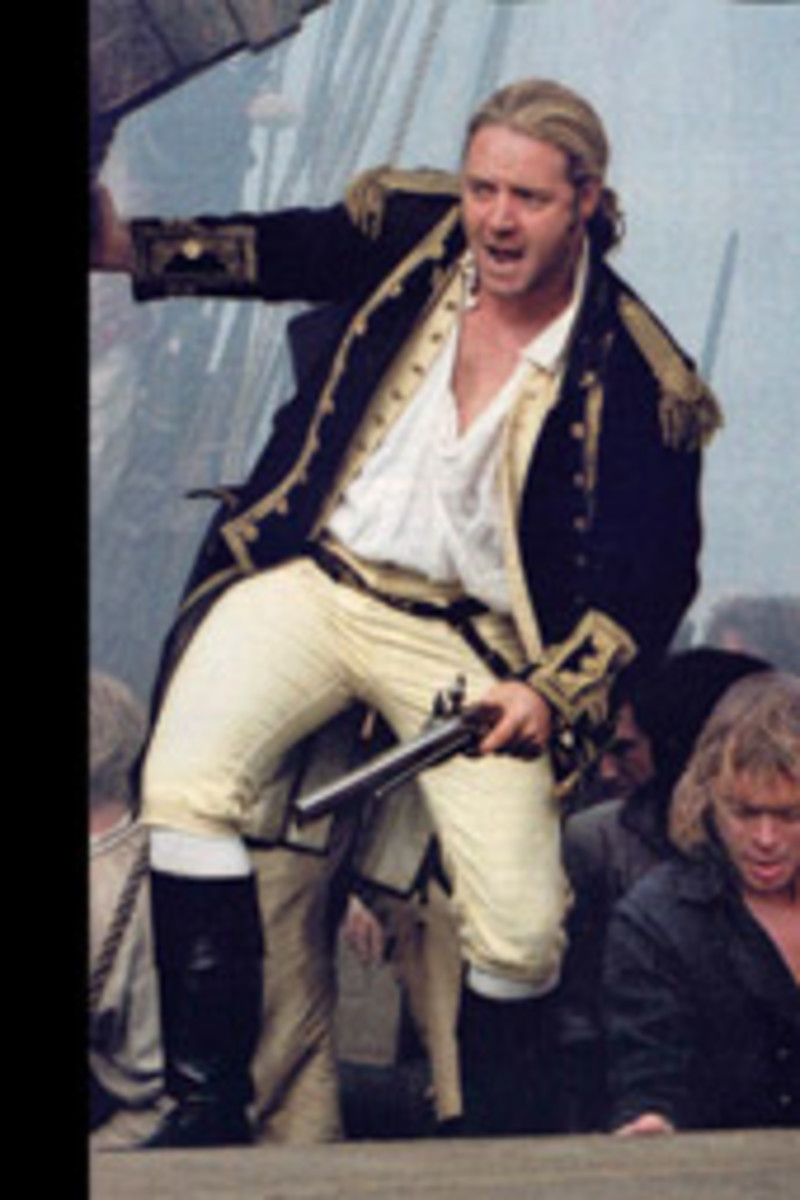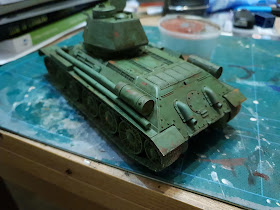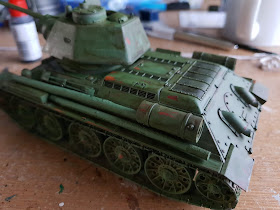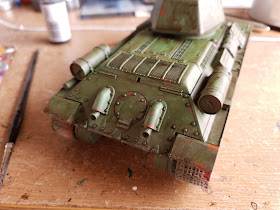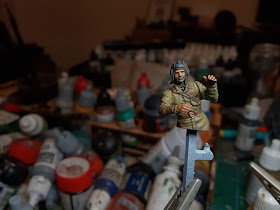Projects
▼
Friday, 30 November 2018
Where now are the horse and the rider?
"For he was a gentle heart and a great king and kept his oaths; and he rose out of the shadows to a last fair morning."
I finally finished painting my new Theoden from the new box set. What a lovely figure to paint - and of one of my favourite characters.
I took my time: inked the armour to get some depth before painting the gold trim. For the flesh, layers of highlights and then a brown filter and pin flesh wash.
For the horse I built the layers up from grey to white and then gave a final glaze of off white to smooth out the transitions. The final touch was to add the Simbelmynë flowers which grew on the graves of the Sons of Eorl - a fitting omen given what he's riding to.
I had a blast painting this and I'm hoping that Santa brings me the new Gandalf.
Sunday, 25 November 2018
Raiders of the Nightvault
In the far north of the Realm of Shadows, winds carry mists
and flurries of snow through long ruined cities. The wind teases a mournful
tune from the shattered remnants of a lost civilisation; but there are more
than ruins here. There are relics of great power for those that
have the will to use them.
The warriors of this ancient place wore armour which somehow
bound itself to them; it granted strength and protection but allowed the wearer
to move lightly, swift of foot. None alive today know how to craft these suits,
nor even how the original wearers bonded with the metal. But the Drune Lords
found a way.
The lowest of their tribes forswear their identities as only
the strongest are allowed to claim a name. Until then they are known by the
trophies of their enemies, skulls and bones and teeth driven into their own
flesh, trophies bound to themselves with chains and hooks. Many an unwary
traveller's final sight has been the blank unfeeling helm staring down upon
them as their skin is flayed from their flesh....
The lowest of them are known as The Faceless.
The strongest of the Faceless, the ones who have fed the Bone
Orchards well with the remains of their enemies, are granted the chance to
undetake the Ordeal of Iron. They are led to darkest groves where the Drune
Lord strip them of their trophies and their clothes; and then they are
presented with the armour. The armour has been in the fire for three days and
glows a sooty red. It is placed onto the new warrior and, as the red hot armour
sears and strips the flesh from his frame, they are both doused in water. When
the hissing steam is gone, swallowed by the eternal mists, most of the warriors
are dead. But some live, sealed screaming into the armour, bound to it, a steel
sarcophagus seared into their flesh.
They are the Skald.
And the Faceless and the Skald march to war.
They march to Shadespire.
Our local Warhammer store is having another painting contest for a small warband and I thought - well, why not? I took a selection of my AOS28 figures who were already part of a similar milieu and set about creating a base for them. I used the trick about photo frames I learnt while doing the T-34 and built it up with foam and polyfilla. I added some slate to match the bases of the miniatures.
And then I started to play.
I'd already played with the LIT pigment before but this seemed to be a perfect opportunity to use it subtly to underline the idea of shadeglass and to feed into the grungy high fantasy aestherticm I'm looking for in AOS28.
I'll keep you posted on the results, but it would be nice for some more AOS28 stuff to win, wouldn't it?
UPDATE: I WON!
Wednesday, 21 November 2018
Master and Commander Redux
“Jack and Stephen were neither of them human until the first
pot of coffee was down, hot and strong.”
One issue has always been that there hasn't been a good 28mm version of either Lucky Jack or Stephen - until now.
This is the Limited Edition miniature that Warlord Games shipped with their 2nd edition Black Powder rules. I have no need of the rules but wanted the miniature very badly indeed. Luckily, a scholar and gentleman of the Napoleonic Wargamer Facebook group was willing to part with his.
It is a gorgeous sculpt and an incredibly crisp casting.
A quick zenithal prime...
And then basecoating.
Reference material:
I decided quite early on to go for a holystoned deck for the base as it would make the darkness of the coat stand out more. Incidentally, I have started using airbrush tinner instead of water to thin my paints, even when using a brush. It's genuinely revolutionised my painting - as you'll see with some of the detail work on Lucky Jack.
Daylight test and I'm happy with the custom mixed Navy Blue. Time to do the gold trim.
Sunday, 18 November 2018
Dasvidaniya Rodina
The Soviet T-34 was the tank that won the war. With its revolutionary design and the ruthless industrial might of the USSR behind its construction, it helped halt wehrmacht advance and turn the tide of the war. After watching me building the submarine, the Eldest asked for a model of his own; when he asked for a tank, I knew there was only one to make him. Along the way - although I knew this would be a display model - I experimented with a few new techniques I intend to use on some wargaming miniatures.
Apologies but this going to a very detailed and pic-heavy post as I want to recrod step by step what I did for fufutre reference.
Step one, as always, was construction.
There were a few buts that needed filling.
Sealing the rubber tracks required a bit of medieval technology....
But we ended up with a final piece.
I painted the interior of the turret and breech - althought it seemed very unlikely you'd see in.
making the antenna used the same candle to stretch some sprue - this is the first time I'd ever done this; normally I'd use very thin brass rod.
Now onto the new techniques. I airbrushed the whole thing in rust tones (actually the same as Uruk Hai flesh but with orange patches.
Then I hit the whole thing with Chipping Fluid and let it dry for an hour.
Then I sprayed my base colour; given the historical variation in green paint used across just 1943 alone, I didn't feel too constrained.
Then I started chipping the base colour off, revealing the rust beneath.
Once happy with the overall look of the first layer of subractive weathering, it was timeto start adding. The first was a layer of grime - very, very thin smoky ink in this case.
Then detail painting of the stowage and metal chipping added with a brush and sponge on some hard corners.
The painting of the tank was now finished.
Then a thicker mix with binder creates a paste which becmes mud on the tracks, mudguards and undersides.
Finally a thin mix is gathered onto a flat brush and flicked on a cocktail stick; this creates mud splashes all over the sides, front and rear.
Now it was on to the loader, peering out of the hatch to direct the tank. This turned out to be phenomenally easy - 1/35 is significantly larger than 28mm.
A final daylight test to checkl the colours...
And on to the base. One tip I picked up from the Vallejo youtube tutorials was to use cheap picture frames on the bases - it's amazing how much more professional it makes the thing look. I roughed out the basic look...
Then libreally coated with polyfilla - making sure to create tracks for the tank.
At this point adjusted the mud on the wheels having now got a feel for what the ground will look like.
Aibrushed the base, making sure to change the colour of the disturbed mud where the tracks had churned it up.
Static grass added
And then cracked the old favourite leaf punch out.
And added some water effects in the deeper puddles.
It was then just a matter of gluing the tank down and blending in some more pigment mud paste.
The final piece:


































